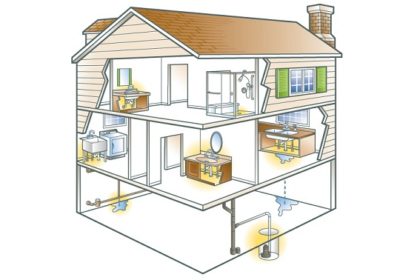
10 things to check about the plumbing before buying a home.
It’s true, older homes are charming and full of character. In many cases the materials stand the test of time but not always; plumbing is a different animal. Below are 10 things to check before writing the big check.
1) Sewer line. Have a professional look at the sewer line to the street. It’s important to run a video camera through the line to identify potential problems. Tree roots, corrosion or clogs can all break down the pipe, and trust us, you don’t want it to collapse.
2) Water heater. Check the age, water heaters should last at least 10 years, if it’s much older than that, you might consider replacing it. Look at the location, will it cause problems if it leaks?
3) Toilets. Check for leaks at the base, this can lead to significant damage. Sealing the leak will make the problem worse. Look for a rocking toilet, discoloration at base or warping. Flush each toilet to make sure there are no clogs.
4) Water supply pipes.
- Determine the age of the pipes and whether or not they have been replaced.
- Are the pipes copper or plastic? If so, they have probably been replaced. Most copper and plastic don’t corrode like steel. However, some plastic is not approved for use inside, such as PVC pipe.
- If they are galvanized steel, they are probably old and will eventually have to be replaced. Look for small holes which could be rust.
- Are the pipes a mixture of different materials? This is usually a sign of minimal repairs being done and could require replacement.
- If the pipes are cast iron, they will have to be replaced because of mineral build up, corrosion or leaks.
- Pipes made from polybutylene should be replaced. These pipes a grayish, flexible plastic used from the 1970’s to the 1990’s. Chlorine erodes them over time.
- All lead pipes should be replaced.
5) Inside water lines. Check the lines you can see—either under the sink or in the basement ceiling. Look for water discoloration or leaks.
6) Drain lines. Even though these lines generally don’t corrode, play it safe and look down the drain.
7) Water taps. Turn on the taps to check for rust. If the home has been sitting vacant, it’s normal for a bit of rust to drain out, but if the house is occupied it could be corrosion.
8) Water Pressure. To test the water pressure, turn on all faucets at once. To get high enough pressure, you’ll need 3/4” pipes from water source to home, and at least a 1/2” or more to faucets.
9) Crawl space and basements. Look for water damage, leaky pipes or inadequate repairs.
10) Shower pressure. Although there are many models with varying pressure, make sure there is a solid stream of water.



